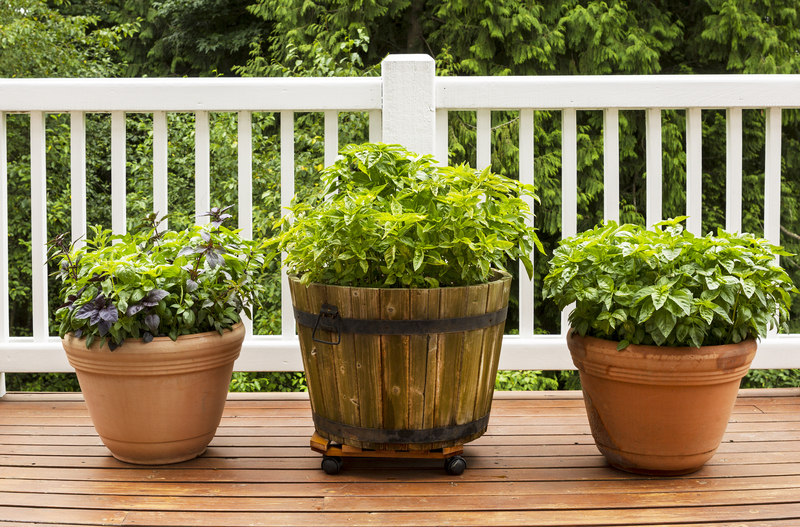3 Simple Tips to Dramatically Reduce Weed Growth
Posted on 08/09/2025
3 Simple Tips to Dramatically Reduce Weed Growth
Whether you're an avid gardener or a homeowner seeking to maintain a pristine yard, weed control is one of the most persistent challenges you'll encounter. Weeds not only compete with your plants for nutrients and sunlight but also mar the overall appearance of your landscape. If you're searching for simple ways to control weeds, you've come to the right place. In this comprehensive guide, we'll reveal three actionable tips to dramatically reduce weed growth--strategies that are easy to implement, eco-friendly, and effective.
Understanding Weed Growth: Why is Weed Prevention Important?
Before delving into the top weed-reduction methods, it's crucial to understand how and why weeds flourish. Weeds are opportunistic plants that thrive under almost any condition, stealing vital resources from your desired plants. If unchecked, they can:
- Reduce the yield of fruit, vegetable, and flower gardens
- Increase maintenance time and costs
- Harbor pests and diseases
- Degrade curb appeal and property value
Fortunately, with the right strategies and timely effort, you can drastically minimize weed invasion in your garden beds, lawns, and even driveways. Let's dive into the three best tips for reducing weed growth.

Tip 1: Apply Mulch Effectively - Nature's Weed Barrier
How Does Mulching Help Control Weeds?
One of the simplest and most effective weed suppression methods is the use of mulch. Mulch acts as a barrier, preventing sunlight from reaching weed seeds and thus inhibiting their germination and growth.
Types of Mulch for Weed Suppression
- Organic Mulch: Includes wood chips, straw, grass clippings, shredded leaves, and compost. Not only does it block out light, but it also nourishes the soil as it decomposes.
- Inorganic Mulch: Gravel, landscape fabric, or black plastic are popular for driveways or non-plant areas. They offer long-lasting protection against weeds.
How to Apply Mulch Properly
- Clear the Area: Remove all existing weeds by hand-pulling or shallow hoeing before mulching.
- Choose Quality Mulch: Select a mulch type suited to your planting bed or landscape area.
- Spread Generously: Add a layer 2-4 inches deep. Too thin, and light gets through; too thick, and plant roots may suffocate.
- Avoid Stem Contact: Keep mulch a few inches from stems or trunks to prevent rot.
Pro Tip: Top off your mulch layer annually, as it can degrade or thin over time. Consistent mulching is a frontline defense that can reduce weed growth by up to 90%!
Tip 2: Practice Smart Planting Techniques - Crowd Out the Weeds
Creating Dense Plantings to Minimize Weeds
Weeds thrive in bare, disturbed soil. One of the simplest methods for weed reduction is to design your gardens and landscapes with little exposed soil. Dense plantings mean less space and fewer resources for weeds to grow, helping keep your beds healthy and attractive.
Strategies to Design Weed-Resistant Gardens
- Choose Ground Covers: Low-growing perennials like creeping thyme, vinca, or sedum spread quickly and form a natural, living mulch.
- Use Spacing Guides: Follow recommended plant spacing, but lean toward the tighter end when feasible, especially with annuals and bedding plants.
- Overseed Lawns: For lawns, overseed bare or thin patches regularly to keep grass thick, making it difficult for weeds to establish.
- Companion Planting: Grow fast-growing crops or tall plants to shade the soil quickly in vegetable gardens, outcompeting weeds for sunlight.
Care and Maintenance for Weed-Free Plantings
- Regular Watering: Keep your desired plants healthy and vigorous, as healthy plants are more competitive.
- Prompt Replacement: Fill in accidental gaps as soon as possible to avoid empty spaces where weeds could pop up.
- Remove Spent Plants: Don't leave bare patches at the end of a season--plant a cover crop or mulch immediately.
Dense planting not only enhances the aesthetics of your landscape, but it also serves as one of the most reliable long-term weed prevention tactics.
Tip 3: Stay Ahead with Consistent Maintenance - The Power of Persistent Weed Management
Hand-Weeding and Timely Removal
While barriers and plantings are highly effective, some weeds may still sneak in. Consistent maintenance is the ultimate secret to keeping your garden weed-free. The most resourceful gardeners swear by frequent hand weeding or spot treatments before weeds can flower and set seed.
- Inspect Weekly: A quick walkthrough of your yard every week helps catch weeds early, when they're easier to pull.
- Remove the Entire Root: Many weeds, like dandelions, regrow if roots are left behind. Use a weeding tool for deep-rooted invaders.
- Avoid Tilling When Possible: Tilling can bring buried weed seeds to the surface. Only disturb the soil when necessary.
- Dispose of Weeds Properly: Don't compost weeds that have seeds--otherwise, you may be spreading them right back into your garden.
Safe and Efficient Use of Weed Barriers
For extra protection in problem areas, use landscape fabric or cardboard under mulch to block weeds for multiple seasons. However, ensure drainage and allow for water penetration to avoid damaging your plants.
Set a Weed Management Routine
- Mulch or Plant Early: Address new beds or bare patches immediately in spring, before weeds sprout.
- Schedule Weeding: Calendar regular weeding times--short, weekly sessions beat long, exhausting battles.
- Monitor Edges and Borders: Weeds often creep in from edges. Give these areas extra attention.
Persistence is key: Letting your guard down allows a single weed to reseed, undoing months of hard work.
Natural and Chemical-Free Weed Control Methods
If you're passionate about environmentally friendly gardening, prioritizing natural weed control is essential. Here are a few ways to reduce weed growth without chemicals:
- Boiling Water: Pouring boiling water directly on weeds in patios or paths can kill them effectively.
- Vinegar-Based Sprays: Spot-treat weeds with a mixture of vinegar and a few drops of dish soap for organic control (be cautious near desirable plants).
- Flame Weeding: Special flame tools can be used on paths and driveways to destroy weeds without herbicides.

Frequently Asked Questions About Weed Reduction
Does pulling weeds really work to reduce future growth?
Yes, hand-pulling weeds--especially before they flower or seed--is extremely effective in preventing future infestations. Just be sure to remove the roots completely.
Is using landscape fabric worth it for preventing weeds?
Landscape fabric is very effective under mulch or gravel pathways. However, ensure you install it correctly and avoid using it where you'll be planting perennials or shrubs, as it can limit root expansion.
How often should I mulch to keep weeds at bay?
Typically, a fresh layer each year is ideal. Monitor mulch thickness to maintain a consistent 2-4 inch barrier.
What's the best way to keep weeds from coming back?
Layering strategies--mulch, dense plantings, and routine maintenance--is the most reliable approach. Preventing weeds from seeding is key.
Conclusion: Transform Your Garden by Reducing Weed Growth
If you're seeking simple tips to dramatically reduce weed growth in your garden or yard, start with these three core strategies:
- Apply a thick layer of mulch annually for a natural weed barrier.
- Design gardens with dense, healthy plantings to crowd out unwanted invaders.
- Commit to a regular, consistent maintenance routine for long-term weed management.
Combine these weed control methods with natural remedies for chemical-free gardening success. Not only will you enjoy a lush, healthy, and beautiful landscape, but you'll invest less time battling weeds in the long run.
Ready to reclaim your garden? Start today with these three simple tips for reducing weed growth--your plants (and back) will thank you!

